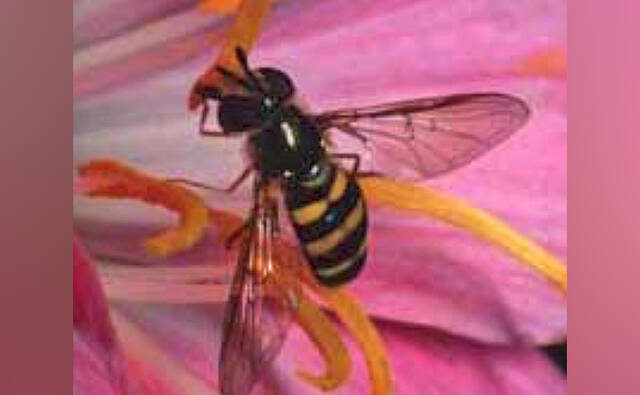The surefire way to know whether it’s a sweat bee or a corn fly buzzing around is if it stings.
The halictid bee stings, but the corn fly, also called a hover fly, does not.
“They’re mimics of bees, just annoying as all get-out,” said Michael Skvarla, a Penn State professor who specializes in identifying bugs. “They just land on you and tickle and it’s frustrating.”
What’s bugging you these days if it’s not mosquitoes or lantern flies?
If it’s an insect, Skvarla can provide a definitive answer.
Corn flies and sweat bees are attracted to sweaty people because they like salt, Skvarla said.
Corn flies eat aphids, caterpillars, mealy bugs and other insects that are considered pests.
The larval form of the species is a tiny white maggot that can thrive on lawns that are left to grow a little too long, Skvarla said.
When they grow wings, they’re attracted to yellow, be it dandelions or a bit of construction equipment, as Skvarla found out when he was using a piece of construction equipment and was surrounded by hundreds of them, he said.
Identify those insects
Skvalra runs Penn State’s insect identification program. People can download a form and send a specimen or photograph of a bug and he will let them know what it is, at no charge. Requests from Pennsylvania residents are handled before others.
In addition to identifying the bug, Skvarla can also provide information about whether the particular insect is a pest and provide suggestions for how to kill them.
Distinguishing different breeds of ants is especially difficult for a lay person. But Skvarla can do so using a photograph or a specimen.
“If they are indoor home pests, you can take control,” Skvarla said. “You can get rid of them.”
‘Normal summer insect fauna’
No-see-ums, a catch-all term for a group of tiny biting flies, are also among the “normal summer insect fauna” flitting about as July wanes and the light of August rises, come Friday.
Other insects that are thriving these days in Pennsylvania include annual dog day cicadas, which can be heard by those braving the muggy weather, and mosquitoes, including those infected with West Nile virus, as found in several neighborhoods in Pittsburgh’s East End, according to the Allegheny County Health Department.
Larvae of black-legged ticks — the ones who can carry Lyme disease — are also starting to appear, Skvarla said.
Beware the New World screwworm
The latest pestilence to be wary of is the resurgence of the New World screwworm, Latin name: cochliomyia hominivorax — literally “man-eater.”
In its larval form, these flies eat living flesh, including humans, albeit rarely.
“Adult screwworm flies are about the size of a housefly. They have orange eyes, a metallic blue or green body, and three dark stripes along their backs,” according to the U.S. Department of Agriculture.
The USDA is monitoring a screwworm outbreak in Central America and Mexico that could be devastating to the beef industry, according to the New York Times.
“With the pest now confirmed just 370 miles south of the U.S.-Mexico border, it is more important than ever to ensure Mexico is held accountable for implementing measures to control New World screwworm,” said Texas & Southwestern Cattle Raisers Association President Carl Ray Polk Jr. in a July 9 statement.
“It is really concerning,” Skvarla said, even though it shouldn’t spread to Pennsylvania.
The New World screwworm in endemic to Cuba, Haiti, the Dominican Republic, and countries in South America, according to the USDA.
It was eliminated from the U.S. using a novel, but expensive, method: exposing male flies to radiation, which renders them sterile and also makes the females sterile once the males attempt to mate, Skvarla said.
“It’s really difficult to sell, raising flies on purpose and shooting them with X-rays,” Skvarla said.
If the screwworm is returns to the U.S. it could cost the beef industry billions, according to the cattle raisers’ association.
Skvarla agreed.
“We can be successful, we just have to be able to get the sterile males where we need to get them,” he said of the screwworms.“We can and have gotten it under control.”








